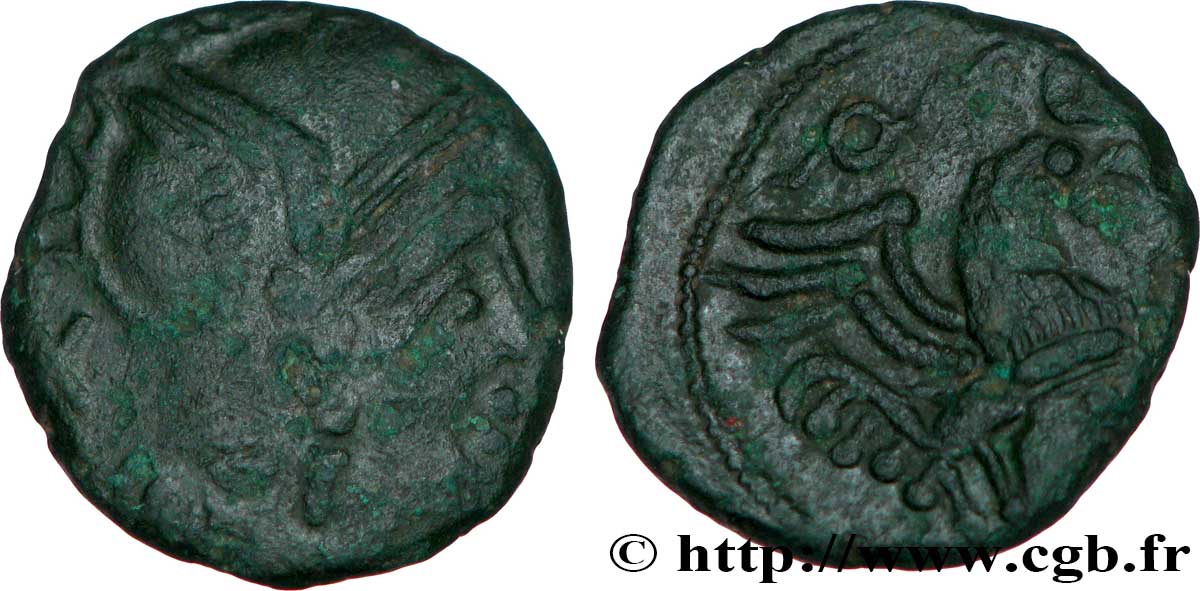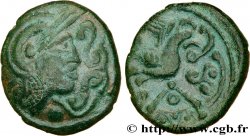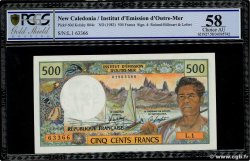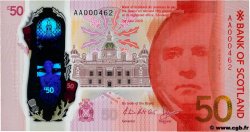bga_290373 - GALLIEN - BELGICA - BELLOVACI (Region die Beauvais) Bronze au coq, “type de Bracquemont”
125.00 €
Menge
In den Warenkorb

Type : Bronze au coq, “type de Bracquemont”
Datum: c. 50-25 AC.
Name der Münzstätte / Stadt : Beauvais (60)
Metall : Bronze
Durchmesser : 16 mm
Stempelstellung : 5 h.
Gewicht : 2,82 g.
Seltenheitsgrad : R1
Kommentare zum Erhaltungszustand:
Bronze avec un droit de frappe molle mais un très beau revers finement détaillé bien que décentré. Patine sombre
N° im Nachschlagewerk :
Vorderseite
Titulatur der Vorderseite ANÉPIGRAPHE.
Beschreibung Vorderseite Tête casquée de Rome à droite ; derrière, X.
Rückseite
Titulatur der Rückseite ANÉPIGRAPHE.
Beschreibung Rückseite Coq debout à droite, le corps formé d'une tête humaine barbue ; devant et derrière le coq, motif serpentiforme, centré d’un annelet.
Kommentare
Ce type a parfois été mal classé et interprété. Le dessin du Lambert (pl. 7, n° 35) est repris dans le Traité de Numismatique gauloise d’A. Blanchet en 1905 (fig. 39). Dans leur inventaire de 1889, Muret et Chabouillet n’avaient pas distingué le masque humain qui orne le poitrail du coq. Ce type est aujourd’hui mieux connu grâce aux travaux de L.-P. Delestrée. Cet exemplaire offre un revers particulièrement net et compréhensible !.
This type has sometimes been misclassified and interpreted. The Lambert drawing (pl. 7, n° 35) is included in the Treatise on Gallic Numismatics by A. Blanchet in 1905 (fig. 39). In their 1889 inventory, Muret and Chabouillet had not distinguished the human mask which adorns the chest of the rooster. This type is better known today thanks to the work of L.-P. Delestrée. This example offers a particularly clear and understandable reverse!
This type has sometimes been misclassified and interpreted. The Lambert drawing (pl. 7, n° 35) is included in the Treatise on Gallic Numismatics by A. Blanchet in 1905 (fig. 39). In their 1889 inventory, Muret and Chabouillet had not distinguished the human mask which adorns the chest of the rooster. This type is better known today thanks to the work of L.-P. Delestrée. This example offers a particularly clear and understandable reverse!








 Berichten über einen Fehler
Berichten über einen Fehler Die Seite drucken
Die Seite drucken Teilen meiner Auswahl
Teilen meiner Auswahl Stellen Sie eine Frage
Stellen Sie eine Frage Einlieferung/Verkauf
Einlieferung/Verkauf
 Details
Details















